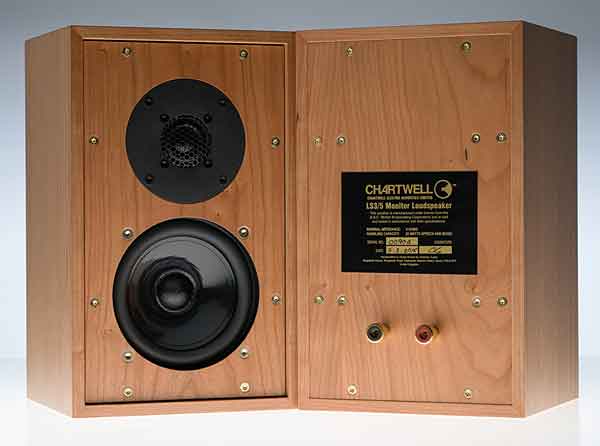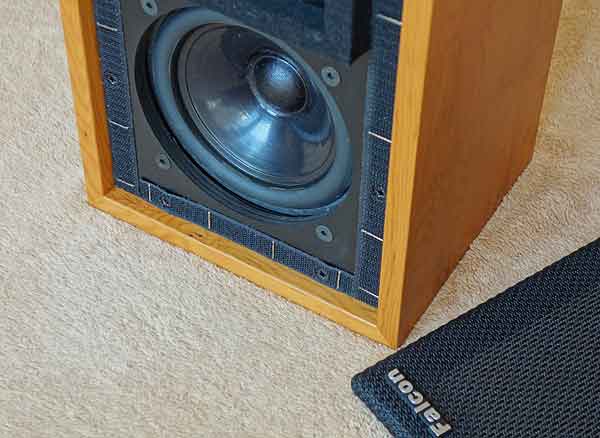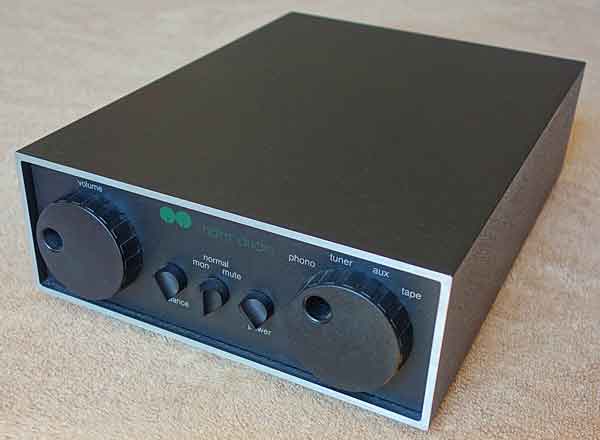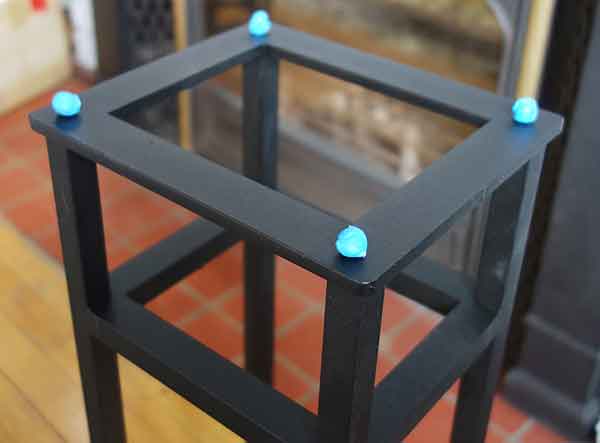| Columns Retired Columns & Blogs |
Great review of the 3 newest examples of the old
BBC monitors. I would like to know if you have any experience
with the Harbeth 3pers and how they compare to these three.

On a recent Sunday morning, while my wife was having tea in the now-livable living room, she asked if I would ever consider reintroducing some or another playback system to that space. I gazed at the corners of the room where once stood DeVore Orangutan O/93 speakers and, before them, my even larger Altec Flamencos, and made an idle observation: "Not much would fit there now, except maybe LS3/5a's."
And that was that: I spoke of the devil, and it wasn't long until he appeared.
It came from the recording van
I tend not to think of the mid-1970s as an auspicious time for great-sounding gear, just as I don't associate the era with the very best-sounding recordings (with exceptions, of course). But at least one nice thing came from that time: the BBC's original design for a loudspeaker initially referred to as the LS3/5: a 12"-tall portable monitor intended for use inside panel trucks and vans during location recording sessions. The LS3/5 was designed around two drivers from KEF—their B110 Bextrene-cone midwoofer and T27 Mylar-dome tweeter—with a slightly complex, phase-correcting crossover network whose component parts had to be individually selected and, in some cases, tuned: As intended, the speaker was so ruthlessly revealing that the slightest deviations from spec became glaringly obvious. The LS3/5 was intended as a tool with which to assess speech intelligibility, performance quality, and freedom from tonal coloration, not as an appliance for delivering pleasing sound in a domestic setting, and certainly not as a dispenser of crotch-tingling deep bass—although a canny response bump at 160Hz, which is two octaves above the fundamental of the lowest string of a double bass, gave the impression of greater low-frequency extension than was actually on tap.
Once the design was finalized, the BBC made 10 pairs of LS3/5's in-house, then set about licensing outside firms—first Rogers Audio, then that firm's eventual holding company, Swisstone, and eventually 10 others—to manufacture all subsequent batches. But in 1974, before outside production began in earnest, the BBC's engineers discovered that KEF had altered, apparently without notice, the designs of the B110 and T27 drivers. That prompted three changes: a redesign of the speaker's crossover, to compensate for the audible differences between the old and new drivers; the installation of a thick felt corral around the tweeter's mounting plate, to keep that driver's output from roaming into the enclosure's front edge; and a new name: LS3/5a (footnote 1).
By 1987, the BBC's engineers made another unhappy discovery: The consistency of KEF's B110 drivers had been less than admirable. There ensued another change to the specs of that driver and, in a compensatory move, to the LS3/5a's crossover, one side effect being a reduction in the speaker's nominal impedance, from a tube-friendly 15 ohms to a tube-cordial 11 ohms—but this time, the model designation went unchanged. And in 2000, KEF threw in the towel and ceased altogether making the B110, prompting licensee Stirling Broadcast to commission bespoke drivers from SEAS and Scan-Speak, engineered by Derek Hughes, son of Spendor founders Spencer and Dorothy Hughes. The BBC smiled their approval; Stirling nevertheless launched their version of the classic portable monitor with a newer name: LS3/5a V2.

Graham Audio, of Newton Abbot, UK—a picturesque village not far from Torquay, which was the setting for Fawlty Towers—recently introduced their own LS3/5a ($2990/pair), making them the model's 12th licensee. This version—for which Graham Audio has revived the brand name Chartwell, which they own—also uses a crossover and bespoke drivers that were engineered by Derek Hughes. Graham's LS3/5a has the same specifications as the 1987–2000 version: a thin-walled (12mm) birch-ply cabinet with a fixed (rather than removable) rear panel and a single pair of input connectors; a nominal impedance of 11 ohms; a frequency response of 70Hz–20kHz, ±3dB; and a rated sensitivity of 83dB.
But this isn't Graham Audio's first crack at making and selling a BBC-designed minimonitor: A few years ago, they became the first-ever company to produce a commercial version of the original BBC minimonitor, which they sell as the Chartwell LS3/5 (also $2990/pair). That speaker was also engineered by the peripatetic Derek Hughes, under direction of Graham Audio's Paul Graham, who told me via e-mail that he did so because "we thought it would be more interesting to go back and recreate the original [because] it was very well thought of, sonically, at the BBC."
That being said, Graham acknowledged that the reason for his recently unveiled LS3/5a was, quite simply, demand: "A number of distributors, particularly in the far east, said their customers wanted the LS3/5a."
A few details: Graham's Chartwell LS3/5a has front baffles that are painted black, then fitted with the above-mentioned felt tweeter barrier, and with Velcro strips to hold in place the speakers' black-fabric grilles; all other cabinet surfaces are finished in a choice of real-wood veneers. The rear panels are glued in place—ie, are nonremovable. The midwoofers have thick coatings of an unidentified dope, and their rubberlike surrounds are extremely pliable.
Graham's Chartwell LS3/5 is a slightly different-looking thing. Here, the front baffle has neither felt nor Velcro—grilles are held in place by hidden magnets—and that baffle shares the same finish as the rest of the speaker (in this case, an extremely nice-looking rosewood veneer). Rear panels are screwed in place and are presumed to be removable. The midwoofers have thinner coatings on their Bextrene cones, their fabric dustcaps even less so. And their surrounds are slightly less pliant than those of the Graham LS3/5a's. Their tweeter domes are made of Mylar, protected by nonremovable metal grilles.
In hushed tones
I had before me a multipronged dilemma:
I wanted to write about Graham Audio's new LS3/5a, yet it seemed irresponsible to do so without anticipating the question that would surely be on some readers' minds: How does it compare to the same company's LS3/5?

Next came the no-less-reasonable question: How do both speakers compare with the Falcon LS3/5a ($2995/pair), which has been praised in recent volumes of Stereophile?
And finally, how could I write a meaningful review by driving three similar-yet-different speakers with an amplifier—my Shindo Haut-Brion—that would seldom if ever be part of such a pairing in the real world?
The first two problems were easily solved: I asked nicely, and Philip O'Hanlon and Pandora Pang of Graham Audio distributor On a Higher Note arranged the loan of both Graham–Chartwell models, as well as a pair of 24"-tall stands ($599/pair) commissioned specifically for the speakers by Washington retailer Gig Harbor Audio. Then I asked Jonathan Derda of Falcon Acoustics distributor MoFi Electronics for a loaner pair of their LS3/5a's, and he kindly packed up and shipped me his own personal pair.

The amplification dilemma was slightly trickier, complicated by the fact that I cannot and will not review an unfamiliar loudspeaker with an amplifier that is similarly new to me: How could I know which product was responsible for which performance characteristics? (footnote 2) Then I remembered the integrated amplifier that so impressed me just three years ago, the classic Naim NAIT 2 as reconditioned by Chris West of AV Options. I spoke with that company's Nick Despotopolous, and he arranged the loan of a NAIT 2 that had been rebuilt to their Ultimate level ($2294, plus the cost of the original amp), owned by customer Nile Garritson. (Thanks, Nile!) As a bonus, the NAIT 2 in question was one of the very few made with Naim's original "chrome-bumper" casework: how cool is that?

I installed the amp on a 20"-tall, half-width Box Furniture rack that I borrowed ages ago from speaker manufacturer John DeVore, now installed near to my living room's front wall. Along for the ride were the Naim ND5 XS 2 network player I reviewed in the April 2019 Stereophile and my Thorens TD 124 turntable, presently fitted with Sorane ZA-12 tonearm and EMT TSD 15 N SPH cartridge. All three speakers were placed on the Gig Harbor stands, each held in place with four wasabi-pea-sized balls of Blu-Tack. In each case, the speakers were 44" from the front wall and either 31" or 35" from their respective side walls, all dimensions measured from the center of the baffle. All three speakers sounded their best when toed in to aim directly at a centrally placed listening seat.
Footnote 2: This reluctance isn't just me trying to look noble—it's a long-standing Stereophile policy.

Great review of the 3 newest examples of the old
BBC monitors. I would like to know if you have any experience
with the Harbeth 3pers and how they compare to these three.

Oddly enough, my thought as I opened up the Stereophile website---"they're gonna review the LS3/5a again, I'll bet."
Had a pair for a moment in the late 1980's. One of the nicest systems I've heard had vintage 3/5a's driven by the Dynaco Pas 3/Dyna 70 combo with an AR XA as a source. Owned by a lute player. They know how to tune things.

Is there a problem with captioning (and crediting) photos in these articles?
This article was a slog with the slight variations in models numbers and the different manufacturers.
Take the opening photo...please. What are we looking at?

... listening to music in a typical small college dorm room today as they were a few decades ago. Back then, an Advent receiver was an excellent match.
https://www.stereophile.com/content/advent-300-receiver
It seems unlikely that most college students shopping for an audio system would end up using these speakers partnered by an obsolete amplifier and a half-century old turntable equipped with a tonearm of obscure origin fitted with a $2K moving-coil cartridge.
AD's review might have had a bit more relevance if he had evaluated the speakers with more contemporary and readily available equipment - for example, an NAD C316BEE V2 integrated amp and (to maintain a vintage aesthetic) a Pro-Ject Classic turntable.
https://nadelectronics.com/product/c-316bee-v2-stereo-integrated-amplifier/
https://www.project-audio.com/en/product/the-classic/

AD has Hegel CD player ......... May be AD could review the Hegel Reference H590 integrated amp/DAC? :-) ........
AD mentioned about it in one of his show reports :-) ..........

Thanks ........ I made the correction :-) ........

I enjoyed Art's review of another LS3/5 variant. And it's a very timely read for me, as I've recently been enjoying my Spendor S-3/5s.
I bought the Spendors in 2002 to flank our TV screen as TV speakers (Plasmas in those days were just monitors). I had other big speakers in my main 2 channel system. The Spendors always amazed me in how natural they sounded with voices, how smooth, and they imaged so well that no matter where we sat the phantom image seemed centered right on the TV screen - no need for a center channel!
Occasionally over the years I've taken them out and put them in the "big rig" to check out and they amazed me every time. It had been many years since I did this and got around to it again a couple weeks ago. I have them well out in the room on stands, about 6-7 feet from the listening sofa. Once again...holy cow! It's just unbelievable how these little speakers weave together so many attributes in one pair of speakers: so warm, so rich, organic, incredibly spacious yet precise in imaging with dense, weighty (though smallish) instrument/voice images. And the tone just seems so "right" for voices, acoustic guitars, snare drums, woodwinds...hell just about everything.
But of all things...voices! The way they recreate the softness and richness of a human being singing, and the sense of projection. Beyond obvious single-singer vocal tracks, even in tons of tracks with backing vocals I've heard a million times I keep getting surprised by the sense of "people" suddenly showing up in the mix, singing to me. How these things dig the human element out of even some artificial mixes is a happy mystery.
I'm completely beguiled by these things and they haven't left my big system since I set them up!
(Powered by CJ Premier 12s/CJ Premier 16LS2 preamp, running vinyl and streaming digital FWIW...)
I totally get why this speaker design is a mythical as it is.
I've never heard any of the other variants of the LS3/5 save, very briefly, the Harbeth version (which was excellent). I hope to encounter others! Art did a really nice job getting across the sonic differences in his comparison.

SE's in my living room set up driven by a restored Mac 240. Lovely.
Bought them years ago, lost them to a runaway Adcom 555, then a very gracious dealer sold me a pair at cost when he saw how crestfallen I was at having totaled pair 1.
Lovely speaker though my curiosity for a purebred LS3/5a pair is hard to fight off - especially with all the recent press from Herb, Art, and others.

I can't believe the reviewer forgot the JR-149. One of the LS3/5a's
BBC developers named Jim Rogers went on to create a new version with the original drivers, but housed in an aluminum cylinder. This speaker's heyday was in the late 70s, imported into the U.S by Paul Heath Audio (Dad) in Rochester, N.Y. Many listeners thought the JR had better bass and imaging among other qualities on direct A-B comparison with the original. Just thought I'd throw this into the mix.

The JR-149 are my main speakers. I think they are pretty great for something this size. I use them for critical assessment when recording. I use a Townshend Allegri passive preamp and a Citation II.
Jerome Sabbagh

..yes the JR-149 was a nice speaker. I have a friend with a pair but I would imagine that the elapse of time has wrought the same decline to all pieces where the reticulated foam grilles have fallen apart due to their sensitivity to UV light. So any 149 found now is likely just to have the metal grille that was originally the support for the foam.
Jim Rogers was not a BBC employee and not, AFAIK, involved in the development of the LS3/5. At the time of its development by the BBC Research Department JR had been running his independent audio company, Rogers, for years. He (or, rather, his company) was, however, one of the earliest manufacturers of the model in quantity for implementation at the BBC and was, therefore, one of the first licensees of the design.
By the time of the JR-149 Jim Rogers was no longer associated with the company bearing his name.

Almost all of the BBC type of monitors have nicely engineered 'BBC dip' in the presence region ....... So, less irritation :-) .........

Search for 'BBC dip' ........ PS Audio has a video posted online explaining 'BBC dip' :-) ..........


I posted my comments in response to tnargs' comments couple of days ago ..... Somehow, my comments disappeared ........ So, I will try to post them again :-) ...........
If the midrange driver cone diameter is 5" or less, a smaller diameter voice coil can be used ....... In that case, the driver cone break-up doesn't start to happen till about 4 to 6 KHz ....... Most of the modern cones are designed that way ........ In that case, the tweeters can be crossed over at around 2 to 3 KHz ........
There may not be a need for the 'BBC dip' :-) .........
Vandersteen Audio has a video posted on their website about cone break-up :-) ..........
BBC monitors of the 70's probably had larger diameter voice coils for the mid/woofers ......... So, they were advocating for the 'BBC dip' in the presence region :-) ..........

Some speakers use a 'filler driver' between the midrange and the tweeter to avoid the cone break-up problems ..... Some examples are Revel Ultima Salon2, Vandersteen models and Vivid Audio models ........ Vivid Audio uses a larger diameter dome between the midrange and the tweeter as a 'filler driver' ......... Stereophile has reviewed and measured several of the above models :-) ..........

Some speakers still use the 'BBC dip' ......... For example ....... Look at the frequency response measurements of DeVore GibbonX, in Stereophile ........ Also, look at the frequency response measurements of the recently reviewed Wilson Audio Sasha DAW and Dali Callisto 6-C. in Hi-Fi News :-) ........

Some speakers like the KEF, Elac, TAD etc. use co-axial drivers ....... The midrange cones in these co-axial drivers are 4 or 5 inches, or less in diameter ........ So, theoretically these cones should not have problems with cone break-up when crossed over with the tweeters :-) ..........

Art they only sound small when used the wrong way.
In a seriously small room two to three feet from your ears they sound HUGE.
That is actually what they were designed for.
Not carrying a big room at midfield distances!

Kudos for the joy you created reading the review.
The only thing missing is price per pound!
I forget who used to talk about amps that way. It made its point about construction and transformers in a charming way.
The Graham Chartwell LS3/5a weighs 11 2/3 pounds. I don't know how I'd work that into the discussion.
Thanks again for a totally fun read.

I lent Art my Nait 2 for the review. I don't know Art personally but I can tell you behind the scenes he was first class. A real gentleman. That amp is quite special to me - it was hard to find a chrome bumper version in such good condition and I put a bunch of money into it with the AV Options Ultimate Nait 2 treatment - so thank you Art for taking such good care of it! Coincidentally, it was partly because of Art's review of the olive Ultimate Nait 2 a while back that I decided to have the treatment done.
While the amp was away I started to wonder if it was really as good as I remembered it to be. When it came back I put on Horowitz at Home (through Rega Apollo/Chord Qutest/Naim Allaes) as background music while I worked. Well, I couldn't work. It's simply stunning. I have found the Nait 2 also has great synergy with ProAc Tablette 10s, which I use in my office.
From reading Art's review of the Falcon and Graham LS35/As it seems there is great synergy with those speakers as well. Even though I have been using vintage Naim gear for a while I have never gotten around to trying BBC monitors. It's probably time to change that. It's refreshing to see that some companies are still making the classic designs.
Apparently some of these old designs, whether amps or speakers, are considered "obsolete" for some reason. Maybe it's simply because they have been around a long time. I don't know. In any event there is nothing obsolete about reaching the Omega Point. That's why Nait2s have been appreciating in value and I presume that's also why LS35/As are still being made.
Thank you Art for doing something different and highlighting these speakers.

Hi
Some 40 years back when I first owned my KEF Celeste II, a 2-way bookshelver with KEF then famous unique B139 flat cone woofer & T27 dome tweeter. I never like its T27 dome tweeter which kept ringing like crazy in mid-hi frequencies.
So I replaced the T27 tweeter with SEAS 87H 1.5" soft-fabric dome tweeter, which incidentally got similar LF roll-off curve of T27.
Yet this Danish tweeter sounds so so much smoother & more balanced without ringing than the KEF T27. I love its sound since day one.
To make my vintage KEF sound even much better, I rebuilt it on a large fiber-glass PCB, replacing the cheapie tiny electrolytic capacitors with large non-polar polypropylene metal film capacitors. I also converted its origin single-wiring design into bi-wiring !!!
Wow, I virtually resurrected my vintage KEF from earth to its music Nirvana !
Listening is believing
Jack L
Canada

I think that the trademark owner is not necessarily the same as the brand using it.